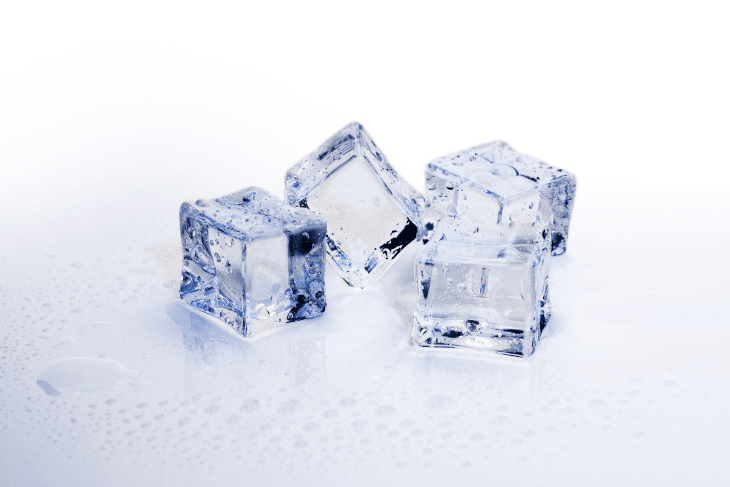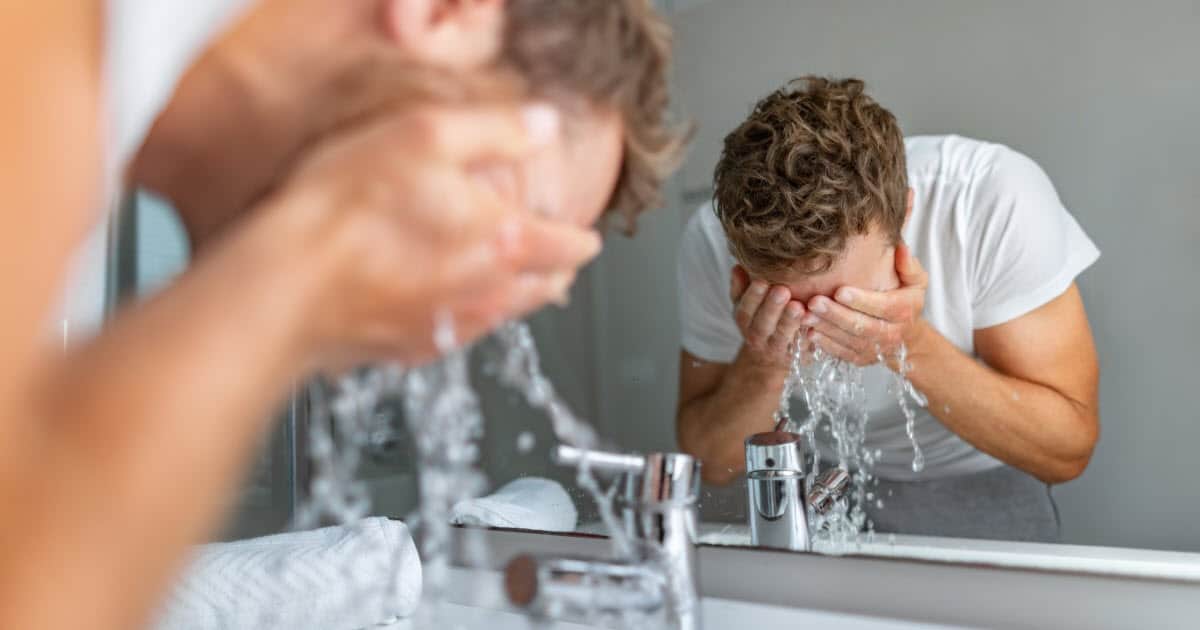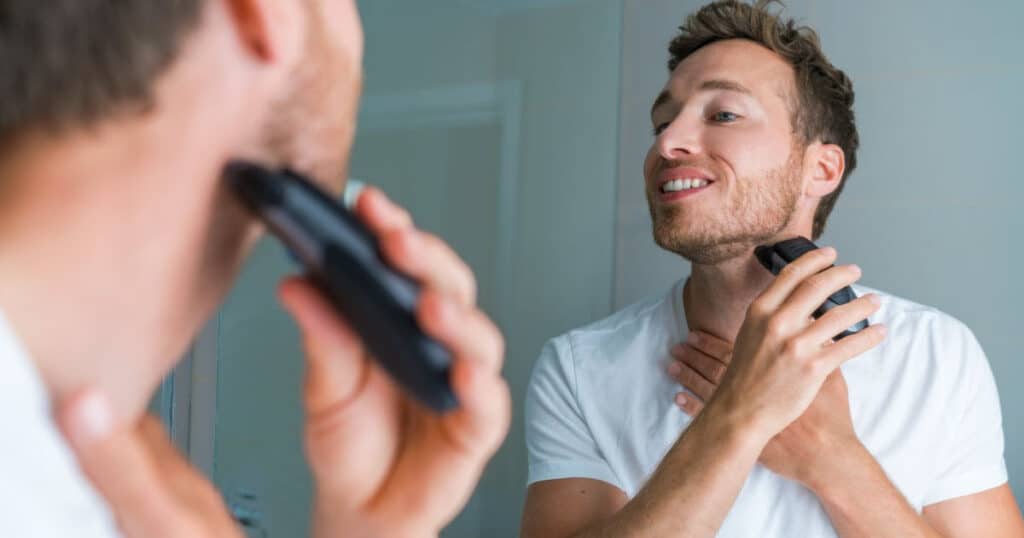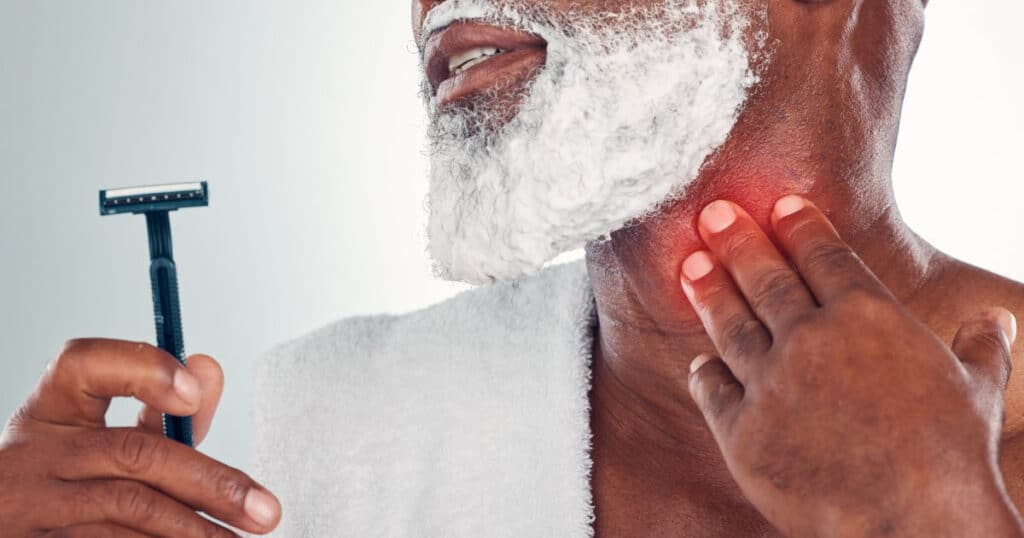The majority of men shave with warm water, and why wouldn’t they? Warm water feels fantastic, and it’s a comforting, calming way to start your day. The idea of shaving with cold water seems a little nutty, and honestly, a little unpleasant.
For some guys, though, it actually works way better than shaving with warm water.
Warm water creates a face ready for shaving on most men, but it’s not the right fit for everyone—and in fact, it can result in razor burn, razor bumps, and various other razor-related issues.
So in this post, we’ll go over an alternative method that sometimes works wonders for some guys: shaving with cold water. We’ll talk about the benefits some guys experience, discuss how to do it if you’re interested, and provide some pointers to make your cold-water shave as effective as possible.

Benefits of Shaving with Cold Water
We’ll start with the big one: effectiveness.
Let’s run through the paces, and look at the start of your “average” shaving routine:
The water is running, steam is filling the bathroom, and after you bathe, you step out of the shower, ready for your shave. Or maybe you’ve skipped the shower, and filled your sink with hot water and you’re about to bring a warm washcloth to your face to clean yourself up before you shave (which, as we’ve written in other posts, is the best way to go about things if you’re skipping the shower).
Either way, you’re warm, and all is wonderful. Your face and your whiskers are soft and pliant and ready for your razor blade, and you can jump into your routine.
That’s standard operating procedure when you’re shaving with warm water, but—and here’s the surprising thing—there are some downsides to having your skin soft and pliant. Even though everyone works this way, it’s sometimes not the best strategy.
When your whiskers are soft and pliant, they lose all stiffness, and become limp—kind of like overdone spaghetti. Nothing will get them upright. Your skin, meanwhile, is stretchy and maybe a little red. All the blood has rushed to the surface of it, and it’s elastic—but a little saggy, too.
So when you take that razor to your face and make that first pass, the razor finds every nook and cranny on your face, and your limp whiskers flop down in front of it. You’re effectively shaving over skin that’s too pliant, and instead of attacking your whiskers from the shaft—remember, they’re floppy and bent-over and lying close to your skin—your shaving them at weird angles, resulting in a non-effective pass.
This isn’t the case for everyone—probably the majority of men shaving their faces with hot water, and they’re fine—but for certain men, hot water creates shaving problems, instead of solving them.
Now, let’s look at it from the cold-water side of things.
You get out of a warm shower, head over to the sink, and splash some cold water on your face. Or, you skip the shower altogether, and wash your face off with a warm washcloth to clean your skin and get it ready for the blade, and then splash some cold water on your face.
Your skin is now taut because you’re using cold water—and that pulls the hair follicles up, making them stand at attention. Think of goosebumps and the raised hairs on the back of your forearm—each whisker is standing at a clear angle from your skin, allowing you to cut it at its base.
All of this can create the opportunity for a clean pass across your skin, slicing through whiskers that are poised and ready to be cut.
Advantages: But Wait, There’s More
Sounds like a better situation, doesn’t it? It’s not a great fit for everyone—as we mentioned (and will probably mention a few more times), most guys shave their face with hot water, and cold water wouldn’t work for them.
That said, we know of a lot of guys who report some other fantastic benefits of shaving with very cold water:
It can result in less razor burn. Those little red bumps are the bane of men everywhere. They’re basically ingrown hairs that result after a shave, and they itch something fierce—to say nothing of the pain and irritation they cause.
So why would could water make a difference?
Imagine how your skin reacts to both agents.
Hot water increases blood flow to the area that you’re about to shave, while cold water, on the other hand, causes the blood to retreat from the area—making your skin more taut, and reducing the chance of your hairs burrowing back under your skin after your shave. That’s a rudimentary explanation—and to be honest, it sounds a little suspect—but some guys swear by it.
You may get fewer nicks. Cuts and scrapes are hard to avoid when shaving, but when you’re shaving with cold water, you may experience fewer of them.
When you rinse your face with cool or cold water, your face is smoother, because you’ve closed your pores and tightened your hair follicles. The skin will lay flatter without the puffiness that hot water causes.
There are now fewer obstacles for your razor blade to catch, and your skin is less elastic underneath the blade—resulting in fewer targets to snag a sharp blade.
Think of it this way: if you were to run a kitchen knife over a loose tablecloth, the fabric of the tablecloth might bunch up under the blade. If you were to run a kitchen knife over a tight tablecloth, you’d probably have an easier time maneuvering it across, and with less disturbance. The same goes for your skin underneath a shaving blade.
It saves time. How many times has this happened to you? Your significant other gets into the shower first. What seems like a day later, you get your chance. And guess what? No hot water.
So much for shaving, you think.
But with cold water, that’s not the case. You can still shave even if you don’t have time to wait for the hot water heater to fill up again.
It can save you money on blades. Because cold-water shaving can be more efficient, you may get more use out of your blades using cold versus hot water. That can be a HUGE deal huge if you’re using pricey cartridge razors that don’t last very long.
Plus, the cold water will probably hurry you along, too! That zap you get from cold water can be very… motivating!
In some cases, it’s a healthier option for your skin. We’ve said this in many of our posts, because it’s the truth: no matter how much we love it, shaving is an irritant. You’re swiping a sharp blade directly over your skin, in an effort to break the hairs follicles growing out of it.
It’s kind of an intense experience, if you think of it that way, and it’s kind of amazing that an irritation-free shave is possible at all.
The trauma that your skin experiences while shaving—and all the cuts involved—can make it vulnerable to infection.
Bacteria loves warm, moist environments—just like the one you create when you shave with warm water. Using cold water can create a less-inviting environment for the microbes that cause skin conditions ranging from acne to infection to razor burn, and while it may not create a totally bacteria-free zone, it can help.
It can be refreshing. We don’t have to convince you that warm water feels nice—it’s wonderful. If you’ve ever spent the day at a sauna or spa, you know how fantastic it can feel.
But cold water can feel fantastic, too. That bracing jolt can really wake you up in the morning, and if you need to be alert—and be alert quickly—there’s nothing quick like it.
And, not only that—because cold water can have a numbing effect, it may mean less pain if you do happen to nick yourself while you’re going through your passes. Win-win!

How to Shave with Cold Water: Tips
Using cold water to shave mixes up the game a bit, so we’ll go over what you need to know in detail before you take the plunge. Keep in mind, you may need to give it a few tries, just to get over that shock factor, and make sure you’re doing things right.
Rinse your face. You still need to start with this vital step, no matter what the temperature of the water you shave with. It’ll remove the surface bacteria that can cause skin problems after the fact.
We’d actually recommend that you rinse and wash your face with warm water, as that will remove more bacteria from your face.
Once you’ve given your face a proper wash, you can splash some cold water on there—ranging anywhere from “cool” to “Arctic”—and then…
Don’t be stingy with the shaving cream. Dry shaving with an electric razor can be a great thing, but dry shaving with a regular razor is almost always a bad thing.
This is to say: shaving cream is important. It moisturizes your skin while creating a barrier to protect it from the sharpness and severity of the razor.
Not only that, but it prepares your whiskers for the blade, too. It softens them up a bit, without tamping them down or bending them over closer to the skin (like in our “overcooked spaghetti” example, above).
So be generous with the shaving cream, and work it into a thick lather. If you’re using traditional wet shaving supplies, whip it up into a froth in your shaving bowl, and use a badger brush to apply it to your cheeks, jawline, and neck.
Skip the pre-shave oil. We’re big fans of pre-shave oil, and it’s a FANTASTIC component when you’re shaving with warm/hot water. It coats the skin and provides some excellent lubrication.
If you haven’t tried it, we’d urge you to give it a shot—it’s really something.
It’s not, however, a great option when you’re cold-water shaving. Pre-shave oil gets thicker and gooier at low temperatures, and that makes it very difficult to use—it applies unevenly, clumps up, and congeals in your razor (which is kind of gross).
So skip the pre-shave oil for now, and go back to it when you’re having a hot-water shave.
Start shaving. We’ve written at length about shaving technique elsewhere, so we’ll assume you got this part of it (and you can read our other posts if you need help with technique).
There are, however, two things we should share when it comes to actually shaving:
1) You may find that the tautness of your skin is just enough to make one with-the-grain pass sufficient for a clean shave. That’s often the case, so after your with-the-grain pass, inspect your skin and see how you’re doing.
2) If you find you need another pass, take your across-the-grain and/or against-the-grain pass very slowly, and do it with great care. Cold-water shaving is a new experience for your skin, and irritation can occur. If you find the across-the-grain and/or against-the-grain pass with cold water irritate your skin, perhaps you can try a second with-the-grain pass instead.
The point is, take it easy, and go slow.
Cool off, dry off. When you feel like you’ve got the job done, rinse your face with cold water again. It will get rid of any residual shaving cream and stray hairs, and it will also close those pores again.
Then, dry off with a clean towel, taking care not to rub excessively. A gentle patting motion will suffice. Remember that your skin is still on hyper-alert for irritation even with the cold water.
Check for damage. The cold water may dull the pain from a nick, so take a second—even if you feel like you don’t have any cuts—and see if you’re bleeding.
Because your skin is cold and tight, it may take a second or two for blood to appear. You’ll see the telltale red spots appear as your skin warms. Treat any nicks you find with a non-irritating ointment and/or an alum block.
Baby your skin. Aftercare for shaving with hot or cold water is the same. Use a high-quality balm that doesn’t contain alcohol. Apply it to everywhere you covered, including your neck. Use of these products helps to seal moisture in your skin to avoid drying, especially during the colder months of the year.
Get used to it. You’ll likely find that using cold water isn’t a lot different than hot water, aside from the few temperature-specific points that we raised.
It is a little intimidating, though, and the first few attempts are often a bit shocking. If it works for you, and you find that you have less irritation and few bumps—hang in there. It gets easier, and after a while, you might even find that you look forward that morning jolt!
Be Careful of the Following
We’d be remiss if we didn’t touch on some of the things you’ll want to avoid when shaving with cool water. The first depends a lot on your water source:
Keep an eye on hard water vs. soft water. When it comes to how well a shaving cream will perform, temperature isn’t typically a major factor—it’s more likely the hardness of the water that will determine how well it works (and how easily it washes off).
Just as a quick review: hard water contains a lot of minerals (including calcium), and it can make it difficult to shave—it can be harder to build up a lather with your shaving cream, and it can be harder to get that shaving cream off your face.
Soft water, on the other hand, doesn’t have many minerals in it, and it’s pretty easy to shave with soft water.
See how your shaving cream reacts, and if you’re having a difficult time forming a lather—or getting it off your face—see if you can use a different water source, or see if you can find another shaving cream.
In our experience, Taylor of Old Bond Street works well with hard water, as does Proraso.
Kid glove handling. Cold water does dull the sensations and your perceptions of them, but don’t let that be an excuse to press harder with the razor. Gentle is still the word of the day, and we can’t urge this enough:
Take it easy!
Don’t let the numbness give you a license to treat your skin roughly. You’ll experience the same irritation once it warms up that the temperature may have abated.
Whisker effects. As we discussed above, cold water will cause your whiskers to stand at attention. However, you may find shaving a bit more difficult, especially if you have coarse hair.
That’s one reason why we stress the importance of sharp blades. Always use the sharpest blades you can find, and remember that dull blades are often the culprit when it comes to irritation and rashes.
Different feel. You’ll likely notice that your shaving experience will differ in subtle ways when going over to the cold side. That’s to be expected.
It’s a learning curve just like anything else. Give it time.
See If Cold Water Works for You
As we mentioned, the majority of men shave with warm water, and it works for them. If you’re experiencing bumps and irritation—or if you simply want to really wake yourself up in the morning—give cold water a try for the next couple weeks. Who knows? You might like it!
Michael Morris is the head writer here at Rough and Tumble Gentleman. He's got a ducktail beard and loves Brazilian jiu-jitsu. He's married to the woman of his dreams and lives in Brooklyn, NY.




